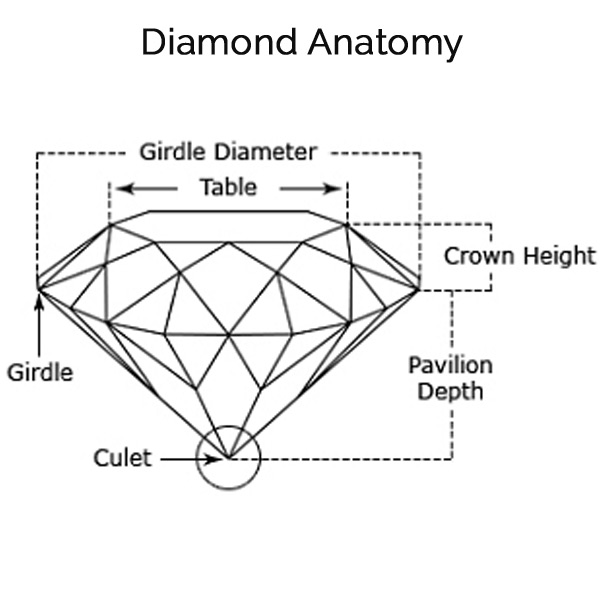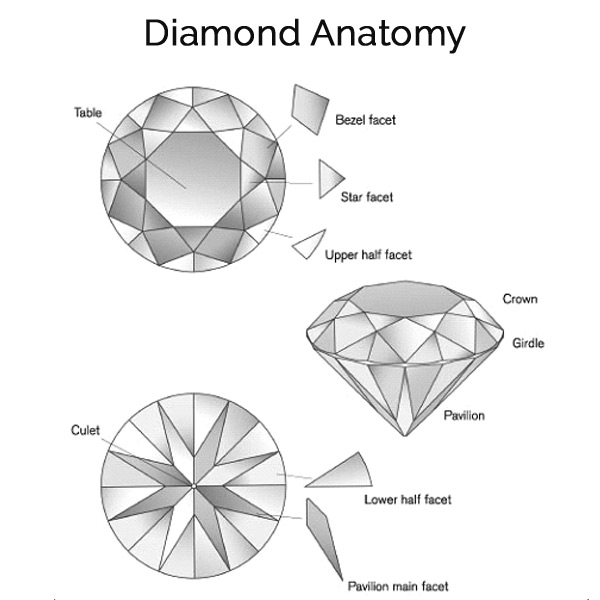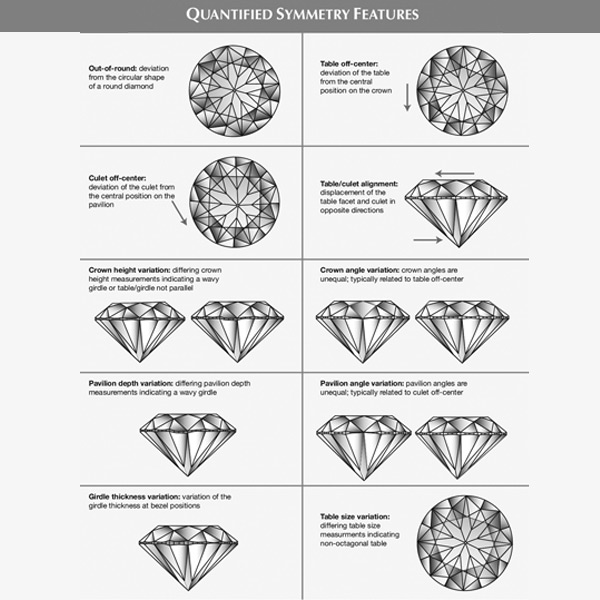- Diameter: Width of a diamond measured through the Girdle.
- Table: Largest facet of a gemstone.
- Crown: Top portion of a diamond extending from the Girdle to the Table.
- Girdle: Intersection of the Crown and Pavilion which defines the perimeter of the diamond.
- Pavilion: Bottom portion of a diamond, extending from the Girdle to the Culet.
- Culet: Facet at the tip of a gemstone. The preferred Culet is not visible with an unaided eye (graded "none" or "small").
- Depth: Height of a gemstone measured from the Culet to the Table.
The cut of a diamond establishes how it reflects light, which is responsible for its sparkle or brilliance. Cut has following three components:
Understanding Diamond Anatomy
It is important to understand the basic terms that define a diamond's anatomy. All of these terms are referred to on most diamond certificates.
- Diameter: The diameter is the width of the diamond from one side of the girdle to the other. The diameter is expressed in millimeter dimensions.
- Table: The table is large, central facet of the diamond at its top. The table proportion is expressed as a percentage that represents the size of the table relative to the size of the diamond's overall surface area.
- Crown: The crown is the series of facets that drop from the table down to the diamond's girdle. The crown is expressed as either a percentage or in radian degrees (or both). This represents the slope of the drop from the table to the diamond's girdle.
- Girdle: The girdle is the edge of the diamond at the point where the crown meets the pavillion. The girdle is expressed in terms that refer to its average thickness or range of thicknesses all around the diamond's girdle. It can also be expressed as a percentage.
- Pavilion: The pavilion is the underside of the diamond that starts at the girdle and extends towards the diamond's culet. The pavillion is expressed as a percentage or radian degrees that represent the slope of the pavillion facets.
- Culet: The culet is the tip at the bottom of the diamond. If there is no facet at the bottom and the diamond comes to a sharp tip then it is represneted as "None". Otherwise, the culet is represented on the certificate in terms that reflect the size of the facet at the tip.
Depth: The depth of a diamond refers to the total height of a diamond, measured from the table to the culet. In round diamonds, the depth is referred to in a percentage that reflects the proportion of the the diamond's depth to the average diameter (taking two cross sections in a round diamond). In shapes other than round the depth is referred to as a percentage representing the proportion of the diamond's height relative to diamond's shorter side (its width).
Proportion, Symmetry, Polish and Fluorescence
Diamond Proportion
In order to maximize light-return and improve the appearance of the diamond, the diamond must have accurate and optimal proportions. Pavillions angles that are too deep or too shallow will cuase light to leak out thereby creating dark areas in the diamond. The crown angles govern the way taht light enters and exits the gem and are therefore also very important.
The pavillion and crown angles work in conjunction with teh diamond's depth and table percentages to define how the diamond is proportioned onto itself. Round diamonds are considered well proportioned when their tables fall between 53 and 59% and their depths fall in the 59 to 62.5% range.
Diamond Symmetry
The Symmetry refers to how precise or aligned the numerous facets of a diamond are. The symmetry of a diamond affects its brilliance and value. Excellent symmetry of a well-cut and well-proportioned diamond enhances the beauty and brilliance of a diamond
Symmetry Grade Table
|
Excellent/Idea
|
An excellent symmetry maintained in a diamond enhances its exquisiteness and brilliance. Diamonds with excellent symmetry have no alignment issues at all and defects of any kind are not visible even under 10x magnification.
|
|
Very Good
|
A very good symmetry maintained in the diamond enhances its splendor and brilliance. Diamonds with very good symmetry have no defects as such and flaws of any kind are extremely difficult to see even under 10x magnification.
|
|
Good
|
A good symmetry maintained in the diamond enhances its beauty and brilliance. Diamonds with good symmetry have minor issues, which are difficult to detect even under 10x magnification.
|
|
Fair
|
A fair symmetry maintained in the diamond allows the light to leak from the stone and makes it appear less lustrous. Diamonds with fair symmetry have flaws that can be detected under 10x magnification and may also be visible to the naked eye.
|
|
Poor
|
A poor symmetry maintained in the diamond misdirects the light entering it and make it appear dull. Diamonds with poor symmetry have flaws that can be easily detected under 10x magnification and are clearly visible to the naked eye.
|
Diamond Polish
Polish refers to the degree of smoothness of each facet of a diamond. It is the diamond cutters art in unleashing the color and beauty within diamond. A quality polish eliminates the unwanted material on the stone and enhances the intensity of light reflected from a diamond.
Polish Grade Table
|
Excellent/Ideal
|
Diamonds with ideal or excellent polish can enhance overall appearance of the stone. Excellent polish in a diamond means that there are no polish defects (i.e. pits, chips, polish lines or scratches) visible at all under 10x magnification or to the naked eye.
|
|
Very Good
|
Diamonds with very good polish can improve overall appearance of the stone. Very Good polish in a diamond means that there are only faint polish lines that can be noticed under 10x magnification with extreme difficulty but are not visible to the naked eye.
|
|
Good
|
Diamonds with good polish improve the look of the stone. Good polish in a diamond means that there are small transparent polish lines that can be noticed under 10x magnification with difficulty, but remain invisible to the naked eye.
|
|
Fair
|
Diamonds with fair polish are less brilliant and are less desirable. Fair polish in a diamond means that defects can be noticed under 10x magnification and can also be visible to the naked eye.
|
|
Poor
|
Diamonds with poor polish look dull and affect the overall appearance of the stone. Poor polish in a diamond means that defects can be noticed under 10x magnification and are even clearly visible to the naked eye.
The most common polish marks are:
- Scratch: A transparent-looking white line on the diamond’s surface.
- Nick: A small notch on a facet or girdle junction.
- Abrasion: A collection of nicks at facet junctions.
- Pit: A small opening in the surface, usually due to inclusions falling out during polishing.
- Lizard skin: A bumpy looking texture.
- Rough girdle: A girdle that has been left unpolished.
- Burn marks: A whitish haze on a diamond’s surface, caused by high temperatures from a polishing wheel.
|
Diamond Fluorescence
The fluorescence in a diamond refers to a kind of illumination that it demonstrates when exposed to ultraviolet radiation. It can also be described as the propensity of a diamond to produce a soft blue colored shine when it is subjected to ultraviolet rays. There are two factors that should be observed when looking for diamond fluorescence. First being the color of the fluorescence and second is the strength of fluorescence. Though it is believed that fluorescence can augment or diminish the beauty of a diamond, but overall it should not be a key factor in the purchase of a diamond.





